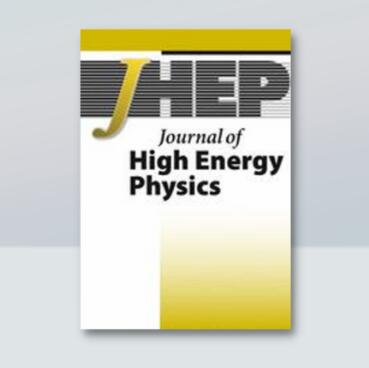畴壁微扰的标量诱导引力波
IF 5.5
1区 物理与天体物理
Q1 Physics and Astronomy
引用次数: 0
摘要
畴壁是在各种新的物理模型中离散对称性自发破缺而产生的二维拓扑缺陷。在这项研究中,我们首次计算了由畴壁网产生的标量扰动产生的引力波。我们的发现表明,引力波的频谱与其他来源的明显不同。这为未来旨在探索畴壁在早期宇宙中的作用的引力波实验开辟了一条有希望的途径。本文章由计算机程序翻译,如有差异,请以英文原文为准。
Scalar-induced gravitational wave from domain wall perturbation
Domain walls represent two-dimensional topological defects that emerge from the spontaneous breaking of discrete symmetries in various new physics models. In this study, we undertake the first calculation of gravitational waves produced by scalar perturbations generated from the domain wall network. Our findings indicate that the gravitational wave spectrum is notably distinct from that of other sources. This opens up a promising avenue for future gravitational wave experiments aimed at exploring the role of domain walls in the early universe.
求助全文
通过发布文献求助,成功后即可免费获取论文全文。
去求助
来源期刊

Journal of High Energy Physics
物理-物理:粒子与场物理
CiteScore
10.30
自引率
46.30%
发文量
2107
审稿时长
1.5 months
期刊介绍:
The aim of the Journal of High Energy Physics (JHEP) is to ensure fast and efficient online publication tools to the scientific community, while keeping that community in charge of every aspect of the peer-review and publication process in order to ensure the highest quality standards in the journal.
Consequently, the Advisory and Editorial Boards, composed of distinguished, active scientists in the field, jointly establish with the Scientific Director the journal''s scientific policy and ensure the scientific quality of accepted articles.
JHEP presently encompasses the following areas of theoretical and experimental physics:
Collider Physics
Underground and Large Array Physics
Quantum Field Theory
Gauge Field Theories
Symmetries
String and Brane Theory
General Relativity and Gravitation
Supersymmetry
Mathematical Methods of Physics
Mostly Solvable Models
Astroparticles
Statistical Field Theories
Mostly Weak Interactions
Mostly Strong Interactions
Quantum Field Theory (phenomenology)
Strings and Branes
Phenomenological Aspects of Supersymmetry
Mostly Strong Interactions (phenomenology).
 求助内容:
求助内容: 应助结果提醒方式:
应助结果提醒方式:


